
Louis XVI Style Elbow Chairs with Mismatched Green Patchwork Upholstery
A pair of Louis XVI style elbow chairs, French, late 19th century, white painted frames, re-upholstered in mismatched green patchwork with floral embroidery, 101 cm high, 60 cm wide, 56 cm deep, seat height 45 cm

Louis XVI Style French Bergeres in Blue and White Fabric
Pair of Louis XVI style French bergeres. Most likely of painted beechwood. Upholstered in a blue and white fabric. 20th century. (2)

Louis XVI Style Beech Fauteuils en Cabriolet with Colefax Fabric
A pair of Louis XVI style beech framed fauteuils en cabriolet, each with a square moulded back flanking the padded arms on fluted baluster leap, the upholstered seat above moulded apron on turned, stop-fluted tapering supports, upholstered in Colefax &…

Louis XV Beech Marquise by Jean Baptiste Boulard, 1755
A Louis XV beech marquise, by Jean Baptiste Boulard (maitre in 1755) the moulded frame with flowerhead cresting, cabriole legs and apron, stamped twice J.B. Boulard and upholstered in silver, gold and peony woven brocade.. Provenance: Andre & Cecile Fink…

Green Painted Louis XVI Bergere Chair with Melograno Upholstery
Louis XVI painted beech bergere, c. 1780, tapered rectangular back above swept padded arms supported by spiral fluted balusters, on tapered fluted and turned legs, retaining original green painted finish with Scalamandre Melograno antique white woven…
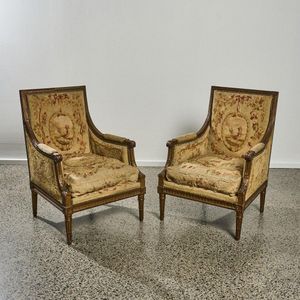
Louis XVI Fauteuils with Aubusson Tapestry Upholstery
A pair of Louis XVI French fauteuils, a pair of 19th century Louis XVI style fauteuil a la reine. Carved and giltwood frames with the original Aubusson tapestry upholstery. Height 96 cm, width 67.5 cm, depth 64 cm
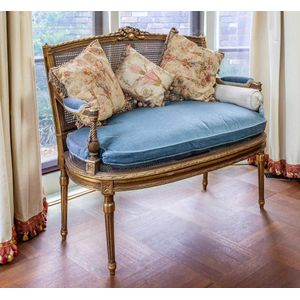
Louis XVI Style Canape & Side Chairs, 1900
A Louis XVI style canape and pair of gilt-wood caned side chairs French circa 1900 canape 98 cm wide, 110 cm high, 55 cm deep
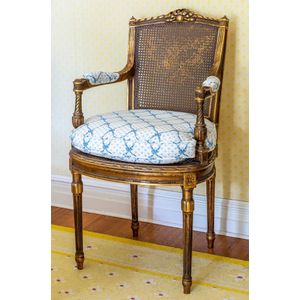
Louis XVI Style Gilt-Wood Armchairs, French 1900
A pair of Louis XVI style gilt-wood and caned back armchairs, French circa 1900 94 cm high, 54 cm wide

Louis XVI Giltwood Armchairs with Silk Damask Upholstery
Pair of Louis XVI style giltwood armchairs, 19th century, carved frames, with padded back and seat upholstered in red and white silk damask, on fluted tapering legs (2), height 98 cm. Provenance: Martyn Cook. Private Collection, Sydney

Louis XVI Fauteuil en Cabriolet with Flowered Silk Upholstery
A Louis XVI fauteuil En Cabriolet, the oval moulded back flanked by upholstered swept arms on stop fluted supports above a shaped seat on turned and fluted legs, upholstered in flower sprigged striped silk, height 92 cm
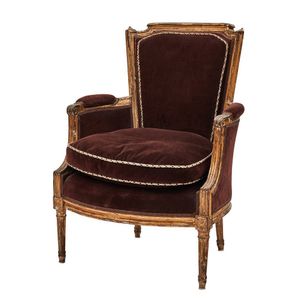
Giltwood Bergere with Chocolate Velvet Upholstery
A Louis XVI giltwood bergere, the moulded frame with squared back and curved upholstered arms flanking the padded seat, on turned and fluted legs with carved flower headers, upholstered in chocolate velvet, height 95 cm
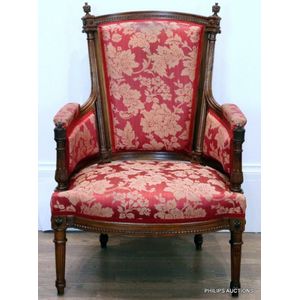
Louis XVI style walnut bergere with red damask upholstery
A Louis XVI style walnut bergere, late 19th/early 20th century, the cartouche upholstered back surmounted by carving and finials, the padded arms with columnar terminals, with a shaped front on tapering turned and fluted legs headed by rosette blocks,…

Louis XVI Mahogany Armchairs in Russet Velvet Upholstery
A pair of Louis XVI style mahogany armchairs, French, 19th century, having square backs with scroll supports, fluted arm supports capped with paterae and conforming tapering legs, upholstered in russet velvet
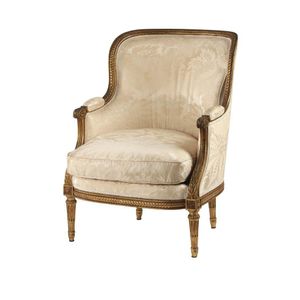
Louis XVI Style Giltwood Bergere, Late 19th Century
A giltwood bergere, late 19th century, in the Louis XVI style, the moulded curved back terminating in padded leaf carved, scrolled arms, standing on stop fluted supports, height 97 cm. Provenance: The property of a gentleman, Sydney
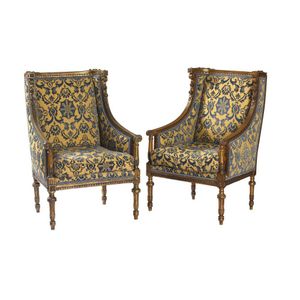
Louis XVI Style Bergeres in Blue Velvet Brocade Upholstery
A pair of Louis XVI style bergeres a l'oreilles, each with a carved frame decorated with flower heads, foliage and scrolls, the fluted armrest supports above turned and fluted legs, in blue and gold velvet brocade upholstery, height 102 cm. Provenance:…

Italian Louis XVI Fruitwood Fauteuil, Late 18th Century
An Italian Louis XVI fruitwood fauteuil, late 18th century, the moulded frame having square padded back with rosettes to the corners, the seat flanked by scrolled padded arms, on moulded legs with rosette headers, upholstered in tiger skin patterned…

Leopard Print Louis XVI Armchairs
Pair of Louis XVI style giltwood armchairs, 20th century, with leopard print upholstered backs, arms, and seats, raised on cabriole legs (2), height 103 cm. Provenance: Private Collection, Sydney

Gilt Louis XVI Style Dining Chairs
A pair of Louis XVI style gilt upholstered dining chairs, circa 19th century, of typical design, each having an upholstered back and seat set within a gilded moulded frame, 91 cm high

Louis XVI Style Hall Porter's Chairs
A pair of Louis XVI style hall porter's chairs; each with a domed top and upholstered wings, the buttoned back above a padded seat with moulded black painted frame on cabriole legs. Height 152 cm, width 77 cm, depth 75 cm (approx)
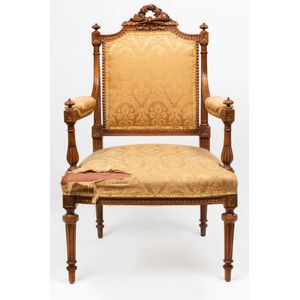
19th Century Louis XVI Armchair in Carved Walnut
A Louis XVI style carved walnut armchair, 19th century
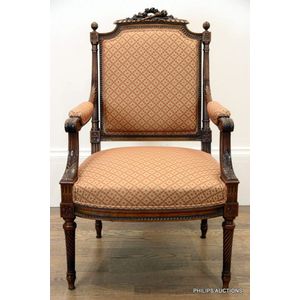
Louis XVI Style Carved Walnut Fauteuil
A fine Louis XVI style carved walnut fauteuil, 19th century, finely carved with a trophy crest and pomegranate finials, fluted supports and acanthus leaf relief decorations to the padded arms above a stuffover seat and elegant tapering spiral twist legs,…
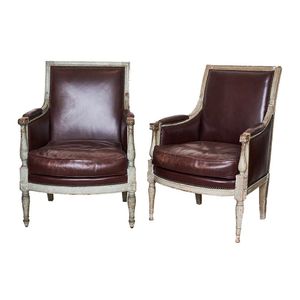
Grey Painted Louis XVI Style Bergeres
Pair of Louis XVI style bergeres, 19th century, each with a grey painted frame, the moulded dome crest rail descending to cut-swept padded arms, on tapering fluted legs, brown leather upholstery (2), height 96 cm. Provenance: The country Trader, Sydney.…
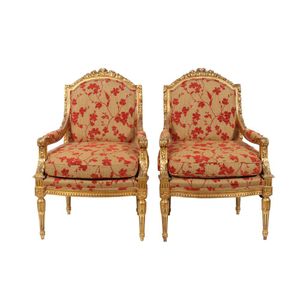
Gilded Louis XVI Armchairs with New Upholstery
Armchairs pair of Louis XVI style Fateuils, gilded carved frames, with fluted legs, new upholstery, height 105 cm

Louis XVI Style Tasseled Fauteuil in Mustard Velvet Upholstery
A Louis XVI style fauteuil in Tasseled upholstery, circa 1860, covered in a mustard velvet, the upholstered arms terminating in finely carved acanthus scrolls, raised upon turned legs and stretchers. 110 cm high, 69 cm wide, 70 cm deep
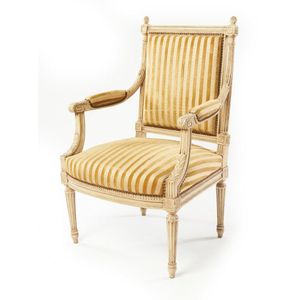
Louis XVI style fauteuil with silk and velour upholstery
A Louis XVI style fauteuil, 19th century, with acorn finials, silk and velour upholstered back, seat, and arm rests. 99 cm high, 65 cm wide, 58 cm deep

Pale Green Louis XVI Wingback Armchair with Striped Fabric
Louis XVI style wing back armchair, in a pale green finish, with upholstered back, sides and cushioned seat, raised on tapered feet, in a cream and blue striped fabric

Gilt Louis XVI armchair with floral upholstery
A Louis XVI style armchair, with ornate carved gilt timber frame finished in gold. Raised on turned and fluted legs tapering to a point. Upholstered with vertical banding of floral motifs over white, separated by navy banding, height 100 cm, width 75 cm,…
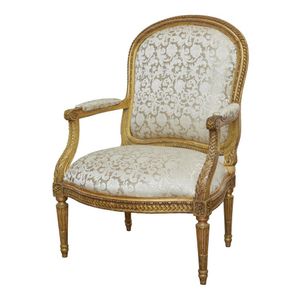
Louis XVI Style Giltwood Armchair, 1880
A giltwood armchair of French Louis XVI style, circa 1880, with lappet and foliate carved frame and fluted tapering legs. Provenance: Sotheby's Sydney, The Norman Wheeler Collection, 14 August 1994, lot 294
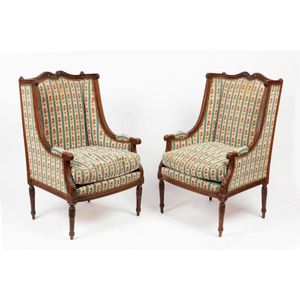
Walnut Foliate Bergeres in Louis XVI Style
A pair of Louis XVI style foliate upholstered walnut bergeres

Giltwood and Painted Chairs from Webb Collection
Louis XVI style giltwood side chair, together with a white painted side chair with carved top rail above a carved vase and lyre splat, both chair with pink upholstery (2). Provenance: The Collection of Janet and Graeme Webb, Wollogorang, NSW

Louis XVI Style Bergere with Mohair Upholstery
French Louis XVI style bergere, 19th century, with arched back above bellflower carved and apricot mohair upholstered seat and cushion, raised on fluted tapering legs. Provenance: The Collection of Janet and Graeme Webb, Wollogorang, NSW
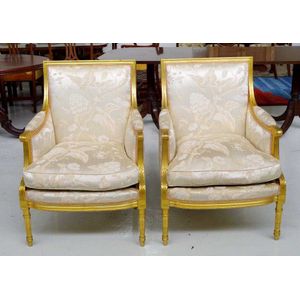
Louis XVI Gilt Wood Bergere Armchair Pair
Pair of Louis XVI style gilt wood bergere armchair 67 cm wide, 96 cm high

Louis XVI style parlour chair with carved relief
A Louis XVI style upholstered parlour chair 19th century decorated with good detail carved relief, traces of old gilding to chair frame height: 97 cm

Louis XVI Style Giltwood Bergeres with Aqua Silk Upholstery
A pair of Louis XVI style giltwood bergeres, 19th century, the rectangular backed chairs with ribbon twist, husk and bead borders to the frames, stiff leaf decoration and whorls to the arms above squab seats and fluted legs, upholstered in aqua silk…

Louis XVI Giltwood Fauteuils with Mauve Silk Upholstery
A pair of Louis XVI style giltwood fauteuils, 19th century, the rectangular backed chairs with husk and bead borders to the frames, stiff, leaf decoration and whorls to the arms above stuffover seats and fluted legs, upholstered in mauve silk taffeta,…

White Louis XVI Chairs with Upholstery (Set of 2)
Pair of French Louis XVI style chairs, in a white painted finish, with white upholstery (2)

Louis XVI Giltwood Armchairs with Floral Upholstery (Pair)
Pair of French Louis XVI giltwood armchairs, with medallion backs surmounted by carved ribbons and rosettes, with padded arms and seat above tapered fluted legs, with floral upholstery (2)

Louis XVI Style Fauteuils with Painted and Gilt Finish
Pair of French Louis XVI style fauteuils, in a painted and gilt finish, with carved ribboned crest rail, above a circular caned back, with cushions back, above a pair of padded arms, above a caned and cushioned seat, raised on four tapering fluted legs,…

Louis XVI Walnut Swivel Chair with Caned Back and Seat
Louis XVI style walnut fauteuil Tournant (swivel chair) 19th century, with caned back and seat, padded armrests, raised on cabriole legs carved with acanthus leaves, height 90 cm. Provenance: The Collection of Mr and Mrs Matthew Handbury, Sydney

Louis XVI Style Bergeres with Carved Scroll and Fluted Legs
A pair of Louis XVI style bergeres, in walnut, limed and parcel gilt, with square back, the arms with carved scroll and foliate decoration resting on tapered fluted legs.
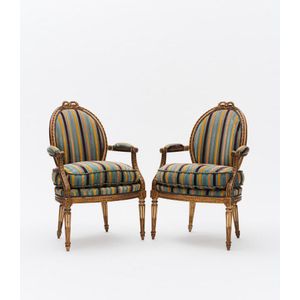
Gilded French Louis XVI Style Fauteuils in Striped Velvet
A pair of French Louis XVI style painted and parcel gilded fauteuils, 20th century, each upholstered in striped cut velvet, with a ribbon-and-acanthus carved frame on tapering fluted legs, 61 cm wide, 48 cm deep, 100 cm high
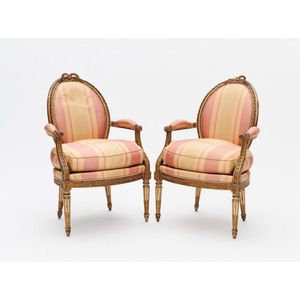
Louis XVI Style Fauteuils with Silk Upholstery
A pair of French Louis XVI style painted and parcel gilded fauteuils, 20th century, each upholstered in silk, with a ribbon-and acanthus carved frame on tapering fluted legs (2), 61 cm wide, 49 cm deep, 100 cm high
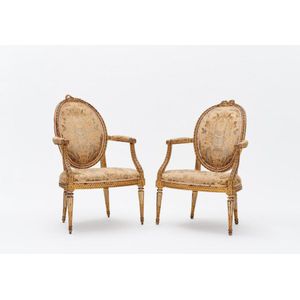
Italian Louis XVI Style Fauteuils, 19th Century
A pair of 19th century north Italian Louis XVI style fauteuils, Fourth quarter 18th century, the oval backs surmounted by ribbon bow, with carved foliate arms and guilloche pattern seat rails, on circular tapering reeded legs, upholstered with worn silk…

Gilt Wood Bergere Chair with Linen Upholstery
A Louis XVI style gilt wood framed bergere wing back chair, with foliate carved cresting rail, arms, apron and cabriole legs, linen upholstered.

Louis XVI Gilt Bergere Chair with Gold Cushion
Antique French Louis XVI gilt bergere chair, with gold velour cushion seat, height 104 cm x width 69 cm

Louis XVI giltwood fauteuil a la Reine with original upholstery
A Louis XVI giltwood fauteuil a la Reine the channelled back rail surmounted by a carved ribbon, the padded back and arm raised on acanthus carved out-swept supports, with original buttoned down upholstery. Provenance: 'The Andre Fink Collection',…

Cream and gilt Louis XVI style fauteuil with floral upholstery
A Louis XVI style cream and gilt painted fauteuil a la Reine, French circa 1900 with satin floral upholstery. Provenance: Shapiro, Sydney, fine silver, Asian & decorative Arts sale, December 2016, lot 7 the David Roche Foundation
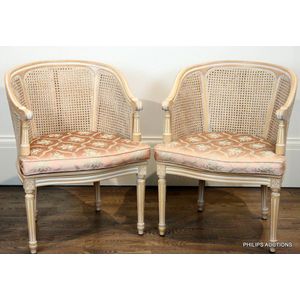
Louis XVI style cane back tub chairs with salmon squabs
A pair of pale timber Louis XVI style cane back tub chairs, later 20th century, with double layer hole to hole cane backs and seats, fluted arm supports and conforming tapering legs with paterae details, with salmon pink trellis pattern squabs with mint…

Gilt Louis XVI Style Side Chair with Cane Seat
A Louis XVI style side chair, carved and gilt with foliate, floral and scroll decoration, on square fluted legs, cane seat, height 82 cm, width 55.5 cm, depth 44 cm

Gilt Louis XVI Salon Chair with Embroidered Upholstery
A Louis XVI style salon chair carved gilt finish, with embroidered upholstery

Louis XVI Style Chairs with Grey Painted Frame and Monogram
Pair of Louis XVI style drawing room chairs, c. 1900, each with grey painted frame, open back with monogram 'Mw' flanked by two arrows tied with ribbons and surmounted by a wreath, seat upholstered in dark green velvet (2), height 87 cm

Louis XVI Style Caned Chairs with Floral Upholstery (Pair)
Pair of Louis XVI style side chairs, c. 1900, white painted and parcel-gilt frame, with caned back and floral upholstery (2), height 105 cm

Walnut Wing Chair in Black Leather Upholstery
A Louis XVI style walnut wing chair, upholstered in black leather
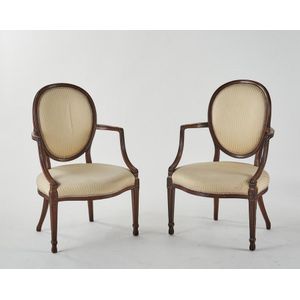
Mahogany Louis XVI Style Fauteuils with Striped Upholstery
A pair of Louis XVI style fauteuils, 19th century, in mahogany with carved in relief with scroll, fluted with rosette decoration. Elegantly arched armrests, terminating in tapered fluted legs, upholstered in striped fabric, height 95 cm, width 59.5 cm,…

Gilt Wood Louis XVI Style Bergeres with Carved Details
Pair of Louis XVI style gilt wood bergeres, with upholstered square backs, above carved scrolled arms on sloping supports, cushioned seat, of carved tapered legs,

Louis XVI Style Walnut Fauteuil with Brass and Blue Upholstery
A French Louis XVI style walnut and brass decorated blue upholstered fauteuil.

Louis XVI Style Gilt Wood Armchairs with Upholstery (Repairs Needed)
Two French Louis XVI style gilt wood armchairs with deep buttoned upholstery, 64 cm wide, 97 cm high Some repairs required

Louis XVI Renaissance Armchair with Walnut & Embroidery
French armchair Louis XVI style, Renaissance revival, walnut & embroidered upholstery

Louis XVI Gilt Wood Side Chair
Louis XVI style gilt wood side chair with caned seat, 40 cm wide, 93 cm high

Louis XVI Style Music Room Chairs (Pair)
Pair of Louis XVI style music room chairs, 19th century, each with a lyre back, padded top-rail and circular seat upholstered in a cream fabric, seat-rail with twisted-ribbon motif and a patera above each leg, on four fluted legs (2), height 88 cm.…

Louis XVI Style Armchairs with Cream Linen Upholstery
Pair of Louis XVI style Parcel-gilt armchairs, early 20th century, each with balloon back, covered in a cream linen upholstery (2), height 96 cm
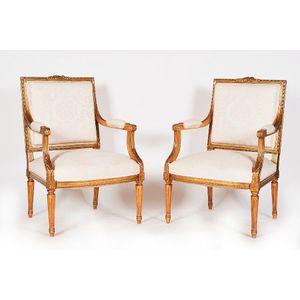
Louis XVI Giltwood Fauteuils with Cream Damask Upholstery
Pair of Louis XVI style giltwood fauteuils, late 19th century, each with a carved ribbon and foliate frame, padded backs, seats and arm-rests re-upholstered in cream damask fabric, on fluted tapering legs (2), height 94 cm. Provenance: Private Collection,…

French Gilt Tapestry Chairs, Louis XVI Style (19th Century)
A pair of French gilt tapestry chairs Likely 19th century Louis XVI style with tapestry upholstery, height 104 cm, width 73 cm, depth 62 cm.

French Louis XVI armchairs (2) with carved beech frames
Pair of French vintage Louis XVI style armchairs with carved beech frames (2)

Walnut Aubusson Armchair, Louis XVI Style
Louis XVI style walnut Aubusson armchair 63 cm, wide, 93 cm, high
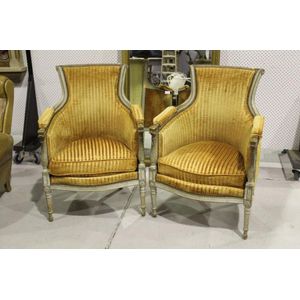
Louis XVI Style Painted Arm Chairs (Pair)
Rare pair of antique French Louis XVI style painted frame arm chairs, with waisted backs and turned baluster supports and front legs (2)
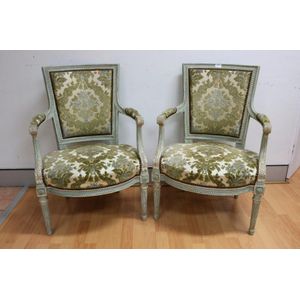
French Louis XVI Armchairs - Distressed Frames (Pair)
Pair of antique French Louis XVI style armchairs, painted distressed frames (2)

Pink Velvet Louis XVI Side Chair
A painted Louis XVI style side chair, cameo backed in pink velvet upholstery, height 78 cm
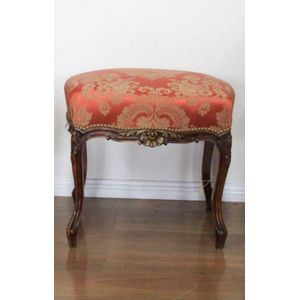
Louis XVI Style Bergere Chairs (9 words)
A pair of French Louis XVI style early 19th century bergere chairs.

Louis XVI Arm Chairs with Down-Filled Seats (Set of 2)
Pair of generous size Louis XVI style arm chairs, large down filled seats, with loose cushion (2)

French Louis XVI Style Occasional Chairs, c1850
A pair of charming French occasional chairs with original painted finish in the Louis XVI manner c1850. 87 cm high.

Louis XVI style chair and stool with leather upholstery
A French Louis XVI manner carved beech chair and matching stool, with original leather upholstery. The chair 92 cm high, the stool 51 cm high

Louis XVI Style Marquises with Gilded Roses
Pair of Louis XVI style parcel gilt walnut Marquises, c. 1900, of corbeille shape, the channelled rope design back rail finely carved with gilded roses, upholstered in velvet, the armrests on scroll supports embellished with gilded acanthus leaves, on…

Pair of Louis XVI Floral Fauteuils
Attributed to Jean Avisse (French, 1723-1796), pair of Louis XVI cream painted fauteuils, 18th century, with channelled back rail, the padded back, seat and armrests upholstered in light blue and cream floral fabric, arms on scroll moulded supports,…

Louis XVI style painted fauteuils, pair
Pair of Louis XVI style carved and painted fauteuils, upholstered oval back and seats (2), height 88 cm

Antique French Louis XVI Walnut 3-Piece Suite
Fine antique French Louis XVI style carved walnut three piece suite (3)

French Louis XVI Chairs with Carved Leaf Decoration
A pair of old French grey/green paint finish walnut open elbow chairs of Louise XVI style, with carved leaf and ribbon decoration, turned and fluted front legs and striped green velvet covers. Minor distress.

Louis XVI Giltwood Bergere Chair
A small Louis XVI style giltwood upholstered bergere, late 19th/20th century

Louis XVI Giltwood Fauteuils in Pink and Sage Green
A pair of Louis XVI style gilt wood fauteuils, upholstered in pink and sage green fabric

Louis XVI Style Open Elbow Chair, Gold and Cream Finish
A French gold and cream paint finish open elbow chair of Louis XVI style, the oval back with lover's knot pediment, the shaped front supported on turned and fluted legs, finely striped covers.

Blue and White Louis XVI Armchairs with Striped Brocade Upholstery
A pair of blue and white painted Louis XVI style armchairs French, 19th century, upholstered in pale cream and blue striped brocade

Faded Velvet Louis XVI Armchair
A Louis XVI style armchair painted finish, faded antique velvet upholstery.

Louis XVI Giltwood Fauteuils in Blue Silk Damask
A pair of Louis XVI style carved giltwood fauteuils, 19th century, upholstered in blue silk damask

Antique French Louis XVI Style Winged Armchair
Fine antique French Louis XVI style armchair, of winged design, finely carved in relief, turned fluted front legs

Louis XVI Style Giltwood Bergere with S Scroll Decoration
A fine 19th century Louis XVI style giltwood bergere, the cresting rail with S scroll and flower head carved decoration, on fluted tapering legs.

Grey and Gilt Louis XVI Armchair with Floral Upholstery
Louis XVI style armchair, 'Fauteuil a la Reine', c. 1900, grey painted with gilt decoration, padded rectangular back, arms and seat with satin floral upholstery, on fluted tapering legs, front legs with castors, height 100 cm width 68 cm depth 62 cm.…

Louis XVI Style Petit Point Fauteuil
A French Louis XVI style oak Petit point fauteuil, 19th century, the tablet back chair with a bead and ribbon twist frame with floral carved crest, with padded arms, relief carved leaf and scroll side supports to a bow front seating rail and raised on…

Pair of Louis XVI Gilded Chairs, 19th Century
Two French Louis XVI style gilded and silk upholstered chairs, 19th century, comprising wingback and side chair, each with finely carved floral crest, (2)

Louis XVI Gilt Wood Fauteuils, Late 19th Century French
A pair of French late 19th century Louis XVI style gilt wood fauteuils.
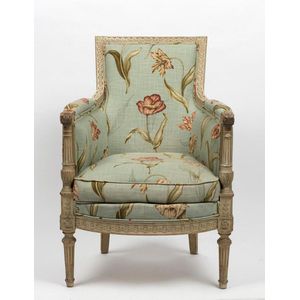
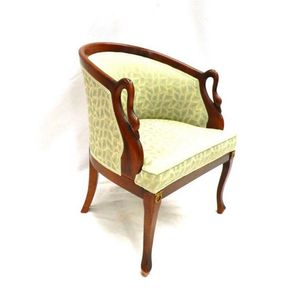



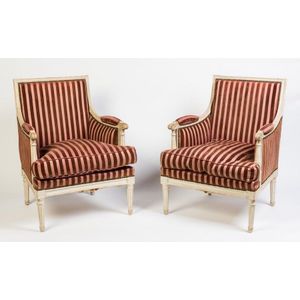

 Loading more...
Loading more...